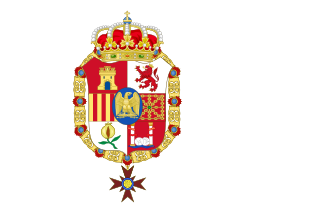
The prime minister of Spain, officially president of the Government, is the head of government of Spain. The prime minister nominates the ministers and chairs the Council of Ministers. In this sense, the prime minister establishes the Government policies and coordinates the actions of the Cabinet members. As chief executive, the prime minister also advises the monarch on the exercise of their royal prerogatives.

The Spanish Constitution is the supreme law of the Kingdom of Spain. It was enacted after its approval in a constitutional referendum; it represents the culmination of the Spanish transition to democracy.

The Cortes Generales are the bicameral legislative chambers of Spain, consisting of the Congress of Deputies and the Senate.

The Political Constitution of the Spanish Monarchy, also known as the Constitution of Cádiz and as La Pepa, was the first Constitution of Spain and one of the earliest codified constitutions in world history. The Constitution was ratified on 19 March 1812 by the Cortes of Cádiz, the first Spanish legislature that included delegates from the entire nation and its possessions, including Spanish America and the Philippines. "It defined Spanish and Spanish American liberalism for the early 19th century."

The Council of Ministers is the main collective decision-making body of the Government of Spain, and it is exclusively composed of the Prime Minister, the deputy prime ministers and the ministers. Junior or deputy ministers such as the Secretaries of State are not members of the Council. The Monarch may also chair the Council when needed on the invitation of the Prime Minister.

Spain in the 19th century was a country in turmoil. Occupied by Napoleon from 1808 to 1814, a massively destructive "liberation war" ensued. Following the Spanish Constitution of 1812, Spain was divided between the 1812 constitution's liberal principles and the absolutism personified by the rule of Ferdinand VII, who repealed the 1812 Constitution for the first time in 1814, only to be forced to swear over the constitution again in 1820 after a liberal pronunciamiento, giving way to the brief Trienio Liberal (1820–1823).

The Cortes of Cádiz was a revival of the traditional cortes, which as an institution had not functioned for many years, but it met as a single body, rather than divided into estates as with previous ones.

The Glorious Revolution took place in Spain in 1868, resulting in the deposition of Queen Isabella II. The success of the revolution marked the beginning of the Sexenio Democrático with the installment of a provisional government.

Agustín Argüelles was a Spanish liberal politician. He served as the 81st and 94th president of the Congress of Deputies.
The Progressive Party was one of the two Spanish political parties that contended for power during the reign of Isabel II. It was to the left of the opposing Moderate Party but also characterised itself as liberal. Like the Moderate Party, it supported Isabel against the claims of the Carlists.
In the history of Spain, the década moderada was the period from May 1844 to July 1854, during which the Moderate Party continuously held power.
In the history of Spain, the bienio progresista was the two-year period from July 1854 to July 1856, during which the Progressive Party attempted to reform the political system of the reign of Isabella II, which had been dominated by the Moderate Party since 1843 in the so-called década moderada. The Progressives were exaltados or veinteañistas, advocates of radical liberalism, in contrast to the conservative liberalism of the doceañistas or Moderates.

Napoleonic Spain was the part of Spain loyal to Joseph I during the Peninsular War (1808–1813), forming a Bonapartist client state officially known as the Kingdom of Spain after the country was partially occupied by forces of the First French Empire.
The Royal Statute of 1834, was a royal charter of the Kingdom of Spain under the rule of Maria Christina, wife of the deceased King Ferdinand VII of Spain, who ruled as Queen Regent during the infancy of her daughter Queen Isabella II of Spain. It came into effect on 10 April 1834.

The reign of Isabella II has been seen as being essential to the modern history of Spain. Isabella's reign spanned the death of Ferdinand VII in 1833 until the Spanish Glorious Revolution of 1868, which forced the Queen into exile and established a liberal state in Spain.
The Exaltados was the label given to the most left-wing or progressive political current of liberalism in nineteenth-century Spain. Associated with, and at times inspired by, French Jacobinism and republicanism, it corresponded to the political current known more generally as Radicalism.

Queen Isabella II of Spain was barely three years of age when her father, King Ferdinand VII, died on 29 September 1833. Her minority age was marked first by the regency of her mother, Maria Christina of the Two Sicilies, and then under General Baldomero Espartero, covering almost ten years of her reign, until 23 July 1843, when Isabella was declared to be of age.
Spanish parliamentarism is a tradition of political representation, legislative activity and governmental control, or parliamentary control of the government, that dates back to the medieval Cortes and the Ancien Régime, in a manner equivalent to the parliamentary system of other Western European nation-states.
Moderantism was, together with Progressivism, one of the two main currents of 19th century Spanish liberalism. It had its origins in the so-called moderates during the Liberal Triennium, who during the reign of Isabella II formed a party, the Moderate Party, which was the party that remained in power the longest and managed to integrate the "reformist" absolutists into its ranks. The less conservative sector of the Moderate Party formed the Liberal Union in 1854. During the Restoration, the members of the Moderate Party joined Antonio Cánovas del Castillo's Liberal-Conservative Party.











